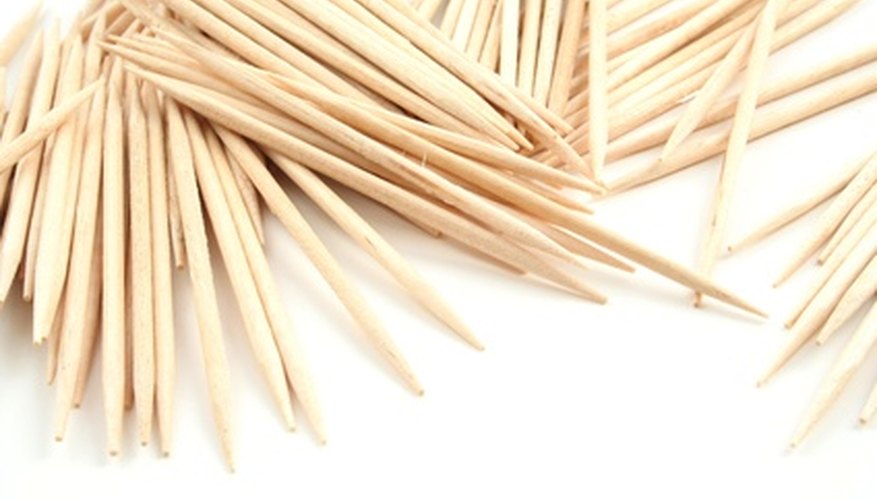Crafting a bridge, which could possibly hold many times its own weight, from nothing but tiny slivers of wood and glue is a feat many people would envy. But while the endeavour may seem simple, without the right understanding of its construction, you may find your bridge collapses before it's completed. By approaching with a well laid-out plan and being methodical and logical, you are sure to construct an enduring bridge.
- Crafting a bridge, which could possibly hold many times its own weight, from nothing but tiny slivers of wood and glue is a feat many people would envy.
- But while the endeavour may seem simple, without the right understanding of its construction, you may find your bridge collapses before it's completed.
Plan out your toothpick bridge by making a simple blueprint on paper. The frequently constructed Warren Truss bridge is covered in this article. If you take deviations, note them on your blueprint before you begin construction and ensure your modifications will hold up.
For the basic Warren Truss design, glue toothpicks end to end horizontally by dabbing two drops of glue at each end until you have about 30 cm (1 foot) in length toothpick construct. Do this twice (one for each side of the bridge).
Glue more toothpicks end to end horizontally, dabbing two drops between them, until you have a beam of about 22.5 cm (3/4 foot) in length. Repeat this again for the second top beam.
Lay one 22.5 cm (3/4 foot) beam and one 30 cm (1 foot) beam horizontally before you, with the shorter beam above the long one. Connect the beams by placing a toothpick at the very end of the long beam, and diagonally lean it onto the short beam and glue it in place, using a couple drops of glue. Repeat for the other side of the beams. You should be left with a long trapezoidal shape. Repeat for the other two beams -- your other 22.5 cm (3/4 foot) and 30 cm (1 foot) piece.
- Glue more toothpicks end to end horizontally, dabbing two drops between them, until you have a beam of about 22.5 cm (3/4 foot) in length.
- Lay one 22.5 cm (3/4 foot) beam and one 30 cm (1 foot) beam horizontally before you, with the shorter beam above the long one.
Glue toothpicks vertically between the beams of your trapezoidal pieces. Cut them if they don't fit as intended. The first toothpicks you place vertically should be placed directly at the intersections of the diagonal stick that connects the beams, forming a right triangle. Place other toothpicks about 5 cm (2 inches) away from these until you run out of room. You should be able to get eight toothpicks laid down. Evenly space them before gluing. Repeat with the other side of the bridge.
- Glue toothpicks vertically between the beams of your trapezoidal pieces.
- Place other toothpicks about 5 cm (2 inches) away from these until you run out of room.
Place toothpicks diagonally between every vertical toothpick, except for the one forming a right triangle. For each side of the bridge, place them at a different diagonal. For example, the first support side may have a diagonal going from left to right if you were looking at it head on, or forming a backslash (), while the other side would have a diagonal going from right to left and form a forward slash (/). Cut the toothpicks into proper shape if they don't fit.
- Place toothpicks diagonally between every vertical toothpick, except for the one forming a right triangle.
Set each trapezoidal piece on its longest base. If you need to, lean one against a wall and use a book or other stable support to keep them upright. Glue toothpicks vertically every 5 cm (2 inches) along the tops of the bridge using a couple of drops of glue for each toothpick.
Reverse the bridge and glue toothpicks vertically connecting the bottom bases starting from each corner and moving inward by approximately 5 cm (2 inches) for each toothpick.
Glue the bridge to the 45 cm (1 1/2 foot) cardboard platform with the long base on the bottom.
Leave the bridge on the platform for at least 12 hours to completely dry. After this time you are free to try testing its weight limits; a bridge of this design should ideally hold at least 2.27 kg (5 lb).
TIP
Depending on the width of your toothpicks, you may want to glue several toothpicks together to make thicker construction material.
WARNING
Allow the glue an hour to dry between steps. Note the potential load bearing problems of any design, and be wary of how much weight you put on your bridge. Better bridges use the maximum strength of each toothpick.
